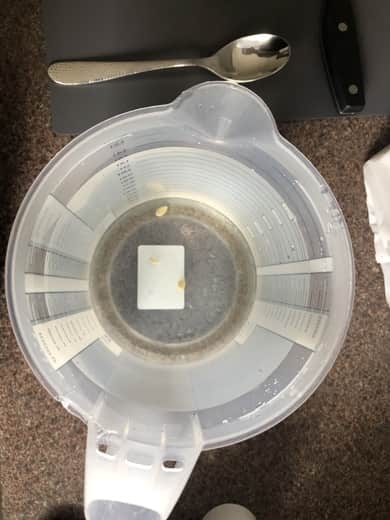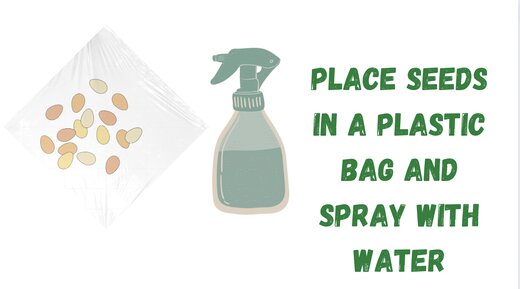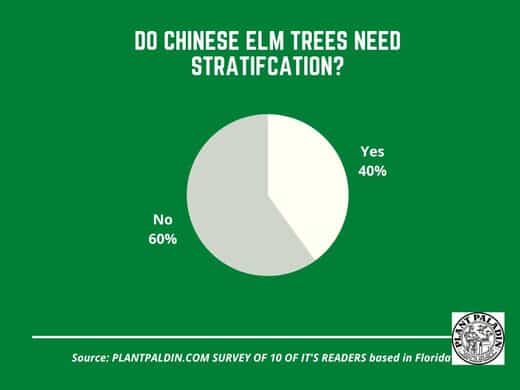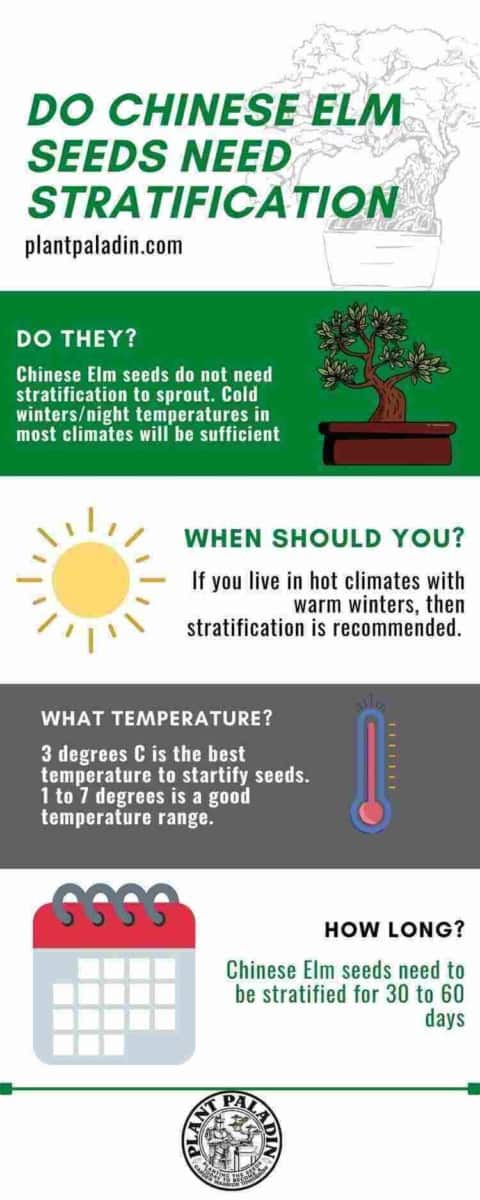This website is supported by its readers. If you click one of my links I may earn a commission. I am also a participant in the Amazon affiliates program and I will also earn a commission from qualified purchases.

So recently, I decided to expand my bonsai tree knowledge and start growing Chinese Elm trees from seed. One roadblock, however, I ran into early one was stratification and if I needed to undertake stratification on the seeds. So do Chinese Elm seeds need stratification?
Chinese Elm seeds do not need stratification to sprout. Cold winters/night temperatures in most climates will be sufficient. Cold stratification in a refrigerator can be undertaken for 30 to 60 days if you want to be 100% sure seeds will sprout.
So in which situations should you stratify Chinese Elm seeds? And what are the best cold stratification then issues for Chinese Elm trees? Keep reading to find out more!
Do Chinese Elm Seeds Need Stratification
Undoubtedly, Chinese Elm trees have to be one of the most popular indoor tree species, not just for bonsai but for generally keeping around the house.
They are super beginner friendly, are very easy to care for, and are pretty tricky to kill.
Having a fair bit of experience in growing Chinese Elm bonsai, I wanted to start the process of developing one from scratch.
One challenge, however, I came across was stratification.
While most trees require some form of stratification to sprout, I wanted to get the most in-depth answer.
As such, I got in touch with a few experts, visited my local botanical gardens, and even did a quick survey of 10 plant paladin readers who own Chinese Elm bonsai trees and asked them; do Chinese Elm seeds need stratification.
To summarize:
- Chinese Elm trees do not need stratification.
- Most of us live in cooler climates with cool nights and colder winters, meaning that you will not need to stratify your seeds.
- These natural cold periods will be enough to ensure that the seeds will be prepared and germinate by the spring when planted.
- Cold stratification is still recommended if you want to be 100% sure that your Chinese Elm trees will stratify.
- Cold stratification can be used in particular when you live in warmer climates that get very mild winters or are growing Chinese Elm trees in a vastly different environment from which they naturally occur – such as the desert. In these scenarios, stratifying your Chinese Elm tree seeds in the refrigerator for 30 to 60 days will typically be enough exposure to the cold to help these seeds propagate.
When do Chinese Elm trees need stratification?
So as mentioned, generally speaking, Chinese Elm trees won’t need stratification.
There are a few scenarios when seeds may require stratification.
These include:
You live in a warm environment
Easily the most common reason why people search if their Chinese Elm seeds stratifying is simply the location that they are based.
Warmer southern or Mediterranean locations like Florida or South America will have warmer climates year-round compared to the temperature UK where I am based.
Our outdoor temperature may not drop low enough in conditions where winters are warmer at night, enabling Chinese Elm trees to stratify.
Consider stratifying in a refrigerator if climates seldom drop below 7 degrees Celsius.
You want to be sure of success
Another reason people want to stratify their Chinese Elm trees is to be 100% sure that their Chinese Elm seeds will sprout.
This can be understandable; after all, why invest in seeds if you are not sure they will grow.
On top of this, let’s say you leave your Chinese Elm seeds to propagate naturally by keeping them outdoors during the winter.
There is a good chance that not all of your seeds will grow, so cold stratification can guarantee that you will have at least somewhat of a decent yield of Chinese Elm seeds.
You are growing a large number of Elm trees
While the average backyard bonsai hobbyist like me will only have a few bonsai trees to their name, bonsai and garden nurseries tend to grow and propagate hundreds of Chinese Elm trees simultaneously.
In these situations, the cost of having seeds that do not propagate is much higher as they can affect these nurseries’ bottom line.
Cold stratifying is also essential to help these types of businesses succeed.
How to stratify Chinese Elm trees
So if you have decided that you want to stratify your Chinese Elm seeds, you must do the following:
Soak your seeds
First, pour lukewarm water into a bucket, then place your seeds in the water for 24 hours.
After 24 hours, you will notice that some seeds will have floated to the top of the bucket and not sink like the rest.
The floating seeds will not germinate so you can remove them.
Then gently remove the seeds that did sink to the bottom and pour the water into the bucket.

Put the seeds in a plastic bag
Next up, place your seeds in a container or plastic bag.
You want to spray the bag with a few squirts from a spritzer to ensure the seeds have moisture and do not dry out.
Alternatively, consider investing in moss like sphagnum moss to keep a moist condition for the seeds.
Then gently place it in a refrigerator.
Damp paper towels can also work if you do not have any plastic bags.

Maintain a cool temperature
Ensure that while the seeds are in the plastic bag, you maintain a steady temperature, just above freezing.
Keeping seeds in the 1 degree Celsius to 5 degrees Celsius is the sweet spot for successful stratification.
Keep the seeds moist
Another essential part of the stratification process is to keep the seeds moist.
Every few days, give the inside of the plastic bag a few more sprays to prevent the seeds from drying out.
If you are using sphagnum moss, update this every week or so.
Keep in the fridge for 30 to 60 days
For Chinese Elm trees, the seeds will typically need to be cold stratified for between 30 and 60 days.
After 30 days, look for signs of roots bursting out of their respective seeds.
When this happens, you can then move your seed into a propagator or small pot and acclimatize it to temperatures outside the refrigerator.
What time of you should you stratify Chinese Elm trees?
Chinese Elm tree seeds need to be stratified during the winter between December and February to be planted successfully in the early spring in March. Ensure any stratification takes place earlier at the beginning of December to ensure the seeds can stratify for 30 to 60 days.
What temperatures do you Stratify Chinese Elm seeds?
Chinese Elm Seeds must be stratified at 37 degrees Fahrenheit (3 degrees Celsius). The best temperature range to stratify Chinese Elm seeds is from 34 degrees Fahrenheit (1 degree Celsius) to 41 degrees Fahrenheit (5 degrees celsius)
What to avoid when stratifying Chinese Elm seeds?
So if you decide to stratify your Chinese Elm seeds, you should avoid a few things.
First, it’s crucial that when you put the seeds inside a plastic bag, you don’t overwater them.
While the seeds need to be kept moist to sprout, spraying them with too much water or moisture can cause them to get fungal infections or fail to germinate altogether.
Too much watering or moisture at this stage can result in mold infections and even yellowing leaves or losing leaves when the leaves grow on your Elm tree.
It’s also essential that you try not to check in on the seeds too frequently too.
While the seeds will need 30 to 60 days to stratify correctly, you mustn’t check the fridge daily to see signs of sprouts.
When you open the plastic bag, you change the refrigerator’s internal temperature, which will take longer for the seeds to stratify.
Finally, consider investing in a propagator.
There is nothing worse than doing the hard work of stratification and then ruining it by not planting your seeds correctly afterward.
What about scarification?
While you can make an argument for stratifying Chinese Elm tree seeds, the same can’t be said for scarification.
For those unfamiliar, scarification is the process of either scratching, sanding, or drilling holes into the seeds to help them sprout roots.
Scarification typically happens when the seeds are more rigid and require extra help to spout.
Not the case with Chinese Elm seeds, which are softer and do not require scarification.
How long does the stratification process take on Elm trees?
Stratification on Chinese Elm tree seeds will take between 30 to 60 days. By day 45, most Chinese Elm trees will have started to grow roots if kept in a plastic bag at a low enough temperature in the refrigerator.
Consider looking at the table below if you have a different tree species.
Bonsai seed species | Time in the refrigerator for cold stratification | Time at room temperature for heat stratification (after cold stratification) |
Scots pine | 90 days | 60 days |
Oak | 30 days | None needed |
Juniper | 60 days | 30 days |
White Pine | 90 days | 60 days |
Maple | 24 hours | 60 days |
Elm | 60 days | None needed |
Red maple | 60 days | 60 days |
Eucalyptus | 60 days | 60 days |
Redbuds | 60 days | 60 days |
When to plant Chinese Elm seeds?
Chinese Elm tree seeds need to be planted in the early spring, ideally in the first few weeks of March. Planting Chinese Elm tree seeds in early spring will allow the seeds to grow during the warm summer months, ensuring you get good growth.
If you stratify the Chinese Elm seeds, do so during the winter 30 to 60 days before the early spring starts.
What is stratification?
Stratification is exposing seeds to cool temperatures to mimic the winter dormancy period. Stratification allows seeds to be grown out of season or can speed up growing plants from seeds.
The stratification process is typically undertaken by keeping seeds in a damp plastic bag or paper towel and moving them into a cool environment for 30 to 120 days.
Refrigerators then are typically used.
How to grow Chinese Elm trees from seed?
Now, if you’re interested in growing an entire Chinese Elm tree from seed, I’ve written a post dedicated specifically to this, which you can check out here.
To summarise briefly, however:
- Purchase your seeds – You can easily buy Chinese Elm seeds in most garden centers or online.
- Consider stratification of your seeds – Most of you will not need to stratify your seeds, but if you do, place them in a plastic bag either with sphagnum moss or spray with a bottle, keep for 30 to 60 days, and your seed should start to grow, remove when you see a visible root.
- Plant in a propagator – Once your seeds start to spout, place your seeds in small yogurt pot-sized pots. Place potting soil and keep it in a propagator for 4 to 6 weeks where you can manage the temperature at this delicate stage.
- Move into a pot – Finally, place and repot your seed into a larger pot that you can keep for a year. Maintain by watering, providing enough sunlight, and fertilizing around once per month.
Survey
Finally, I wanted to finish up with a survey.
I asked ten Plant Paladin readers who own Chinese Elm trees if Chinese Elm trees need stratification.
To summarize:

If you are interested in the process of growing a Chinese Elm tree, I’d also suggest having a look at the table below:
Chinese Elm Bonsai tree Requirements | Explained |
Water | Once per day in the spring-summer or if kept indoors. Once per week if kept outdoors during the winter. Only water if dry to touch. |
Sunlight | 6 hours of direct sunlight in the summer. LED grow light can also be used. |
Temperature | Between 60 degrees F and 100 degrees F |
Fertilizer | Once per month during the spring and summer. No fertilization is required in the fall or winter. |
Repotting | Once every 2 to 3 years in the first 10 years. You can then report once every 5 years |
Placement | Can be placed outdoors in direct sunlight or indoors in a bright spot. |
Wire type | Both copper and aluminum wire can be used. |
Time to grow from scratch into maturity | 8 to 12 years to reach full maturity |
Potting soil | An inorganic Akdama, volcanic ash soil mix works best. |
Growth type | Fast-growing, averaging 12 to 36 inches of growth per year. |
Size | Average store-bought trees are size is one or two-handed bonsai trees - 3 to 10 inches in size, 2 to 8 inches wide |
Lifespan | 50 to 150 years |
Fruit | None |
This post was written by Fehed Nicass who has been passionate about bonsai for over 3 years. He currently resides in the UK and works in sales.

